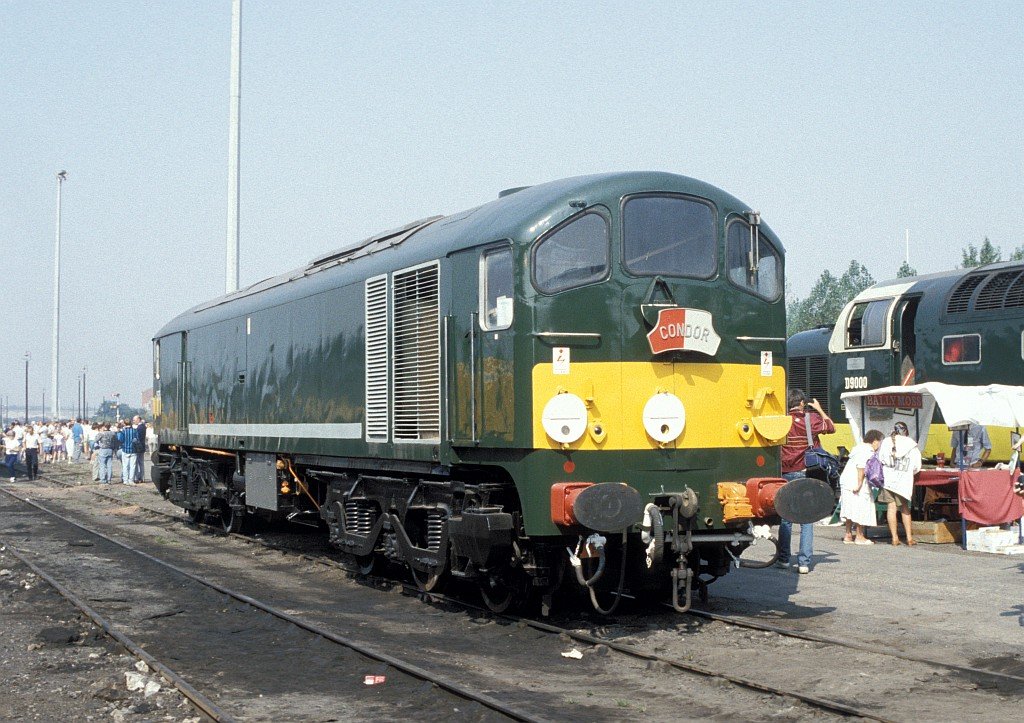- British Rail Class 28
Infobox Locomotive
name = Metropolitan Vickers Type 2
British Rail Class 28
powertype = Diesel-electric
caption = D5705, the sole survivor of the class, at Worksop Open Day on1 September 1991
roadnumber = D5700–D5719
totalproduction = 20
builder =Metropolitan-Vickers ’Bowesfield Works ,Stockton-on-Tees .
builddate = 1958–1959
gauge = RailGauge|ussg|lk=on|al=on
primemover =Crossley HST V8
generator =
tractionmotors = Metropolitan-Vickers 137BZ, 5 off
transmission = DC generator, DC traction motors
whytetype =Co-Bo
uicclass = Co'Bo'
wheeldiameter = convert|3|ft|3+1/2|in|m|3|abbr=on
minimumcurve = convert|3.5|chain|m|lk=in
trainbrakes = Vacuum
locobrakeforce =
wheelbase = convert|42|ft|9|in|m|2|abbr=on
length = convert|56|ft|7+1/2|in|m|2|abbr=on
width = convert|8|ft|6|in|m|2|abbr=on
height = convert|12|ft|1+1/2|in|m|2|abbr=on
weight = convert|97|LT|sigfig=3|lk=on
topspeed = convert|75|mph|km/h|0|abbr=on|lk=on
poweroutput = "Engine:" convert|1200|hp|0|abbr=on|lk=on
tractiveeffort = "Maximum:" convert|50000|lbf|kN|sigfig=3|abbr=on|lk=on
fuelc
convert|510|impgal|abbr=on|lk=on
trainheating = Spannersteam generator (railroad) of convert|1500|lb per hour
multipleworking = ● Red Circle
axleloadclass =Route availability 8
railroad =British Railways
retiredate = December 1967 – September 1969
disposition = One preserved, remainder scrappedTheBritish Rail Class 28 (Metropolitan-Vickers Type 2)diesel locomotive s, or 'Metrovicks' as they were popularly known, were built as part of theBritish Railways Modernisation plan. The locomotives had aCo-Bo wheel arrangement (a 6-wheel bogie at one end, a 4-wheel bogie at the other) – unique in British Railways practice though not uncommon in other countries, notably Japan. This affected theirroute availability , due to the different axle loading at each end of the loco, and made maintenance more complicated. The maximum tractive effort of 50,000 lbf was unusually high for a Type 2 locomotive but, as there were five (not four) driving axles, the risk of wheelslip was minimal.Engine
With low-speed
Crossley 8-cylinder HST Vee8two stroke engine s, they represented an experiment in two stroke versusfour stroke engine s for diesel-electric traction.The engines had
exhaust pulse pressure charging and developed 1,200 horsepower (895 kW) at 625 rpm. There were no valves, and inlet and exhaust were via ports in the cylinder walls. The same engine was originally fitted in the Irish A Class and theWestern Australian Government Railways X classAlmost from the beginning the Metrovick's Crossley engines were problematic. They suffered frequent failures and by 1961 the entire class was handed back to the manufacturer for remedial work on the engines and to cure problems with cab windows falling out while running. The engines were also extremely noisy and prone to unacceptable levels of exhaust fumes.
Operation
All 20 were initially allocated to the Midland Division of BR's
London Midland Region , where they were often used in pairs on the overnightLondon –Glasgow “Condor” express freight service. Later they were transferred to theBarrow-in-Furness area prior to withdrawal after only 11 years at work and in service.Despite the locomotives being otherwise reliable the Crossley engines were still giving problems and
British Rail considered replacing the engines, as was done with the Class 31 diesels. Instead the entire class was withdrawn from service during 1967–1969, and all but one were scrapped by the end of 1969.Preservation
A single locomotive, D5705, survived by historical accident as a technical services engine and then carriage heating unit TDB968006 before being preserved in 1980. It is currently on the
East Lancashire Railway .In fiction
The Class 28 was the basis for "BoCo", a character in
The Railway Series of children's books by the Rev. W. Awdry and the spin-off TV seriesThomas the Tank Engine and Friends .Models
The Class 28 has been made as a
00 gauge model in several forms, including a ready-to-run version byHornby Dublo and a kit by Silver Fox Models.External links
* [http://www.d5705.org.uk Co-Bo World]
* [http://www.silverfoxmodels.co.uk/brd/class28.htm Silver Fox Models (Class 28)] – "includes brief history of class and photo of model inrail blue livery"
Wikimedia Foundation. 2010.
